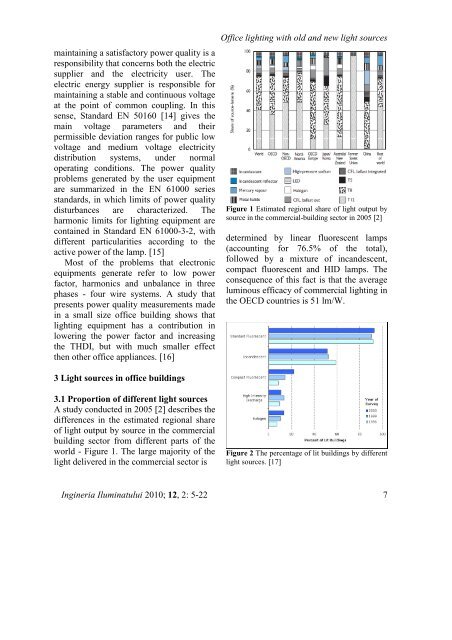ingineria iluminatului - Journal of Lighting Engineering - Prof. Florin ...
ingineria iluminatului - Journal of Lighting Engineering - Prof. Florin ...
ingineria iluminatului - Journal of Lighting Engineering - Prof. Florin ...
You also want an ePaper? Increase the reach of your titles
YUMPU automatically turns print PDFs into web optimized ePapers that Google loves.
maintaining a satisfactory power quality is a<br />
responsibility that concerns both the electric<br />
supplier and the electricity user. The<br />
electric energy supplier is responsible for<br />
maintaining a stable and continuous voltage<br />
at the point <strong>of</strong> common coupling. In this<br />
sense, Standard EN 50160 [14] gives the<br />
main voltage parameters and their<br />
permissible deviation ranges for public low<br />
voltage and medium voltage electricity<br />
distribution systems, under normal<br />
operating conditions. The power quality<br />
problems generated by the user equipment<br />
are summarized in the EN 61000 series<br />
standards, in which limits <strong>of</strong> power quality<br />
disturbances are characterized. The<br />
harmonic limits for lighting equipment are<br />
contained in Standard EN 61000-3-2, with<br />
different particularities according to the<br />
active power <strong>of</strong> the lamp. [15]<br />
Most <strong>of</strong> the problems that electronic<br />
equipments generate refer to low power<br />
factor, harmonics and unbalance in three<br />
phases - four wire systems. A study that<br />
presents power quality measurements made<br />
in a small size <strong>of</strong>fice building shows that<br />
lighting equipment has a contribution in<br />
lowering the power factor and increasing<br />
the THDI, but with much smaller effect<br />
then other <strong>of</strong>fice appliances. [16]<br />
3 Light sources in <strong>of</strong>fice buildings<br />
3.1 Proportion <strong>of</strong> different light sources<br />
A study conducted in 2005 [2] describes the<br />
differences in the estimated regional share<br />
<strong>of</strong> light output by source in the commercial<br />
building sector from different parts <strong>of</strong> the<br />
world - Figure 1. The large majority <strong>of</strong> the<br />
light delivered in the commercial sector is<br />
Office lighting with old and new light sources<br />
Figure 1 Estimated regional share <strong>of</strong> light output by<br />
source in the commercial-building sector in 2005 [2]<br />
determined by linear fluorescent lamps<br />
(accounting for 76.5% <strong>of</strong> the total),<br />
followed by a mixture <strong>of</strong> incandescent,<br />
compact fluorescent and HID lamps. The<br />
consequence <strong>of</strong> this fact is that the average<br />
luminous efficacy <strong>of</strong> commercial lighting in<br />
the OECD countries is 51 lm/W.<br />
Figure 2 The percentage <strong>of</strong> lit buildings by different<br />
light sources. [17]<br />
Ingineria Iluminatului 2010; 12, 2: 5-22 7
















